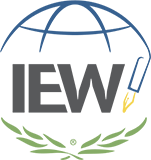The Chesleys are a busy homeschool family. Austin Chesley is the mom of and the primary educator for all five Chesley kids, ranging in age from 10 to 18 years. Dr. Colin Chesley is the Associate Vice President at the College of Health & Public Services at Daytona State College but is also heavily involved in the life and education of his family. Andrew Pudewa was impressed by Colin’s insight and encouraged by how much IEW had benefited the Chesley family. What follows is a conversation with Austin and Colin about how IEW has impacted their homeschool journey.
High Expectations and Curricular Frustrations
I asked the couple to describe what their homeschool was like before they used IEW. Austin shared her initial, enthusiastic expectations. “My grandfather was a librarian, and he instilled a love of learning. I thought that my kids and I would sit around and we would talk about all the literary classics and we would enjoy doing grammar and writing together.” Austin’s vision of what her homeschool classroom would look like differed from reality.
“I didn’t get what I’d hoped for from my boys. I mean I should have expected that a group of boys would want to play and they wouldn’t want to write.”
Austin had a homeschool full of reluctant writers, and things were not working. She had to wrestle with her boys’ resistance to writing simple sentences, and she wiped away more than a few tears. Homeschooling frustrated her. She remembers, “You just want to quit—you think, ‘I can’t do this.’ I was tired and exhausted, and I was on the living room floor. I said, ‘Colin, I want to stop this. I want to quit.’”
Colin wanted his wife to keep trying, so he asked her to give him a couple of days to find a solution. Austin reluctantly agreed.
Finding IEW
While watching the local news, Colin heard about a small local homeschooling convention. He was desperate but hopeful, so the Chesleys took the day off, loaded up their five children, and drove to the event. In the exhibit hall Austin saw a booth that displayed compositions written by students who had learned to write using IEW’s Structure and Style method. She was intrigued about what IEW could accomplish.
Austin mused, “It hit me. This was what I was looking for! It checked off all the boxes. It didn’t matter if my kids had struggles or if they had challenges; there was something for them. They could learn to write.”
Using IEW
The Chesleys joined a co-op that was using IEW’s Medieval History-Based Writing Lessons, and Austin remembers how the curriculum affected her oldest boy in particular that first year. “The tears went away. When you have boys and there are swords involved, it just completely draws them in.”
By the end of their first year of IEW, the Chesley boys had greatly improved their writing skills. Colin highlighted his oldest son’s dramatic improvement. “He went from resisting even writing a paper to writing an entire composition, three body paragraphs, an introduction and a conclusion, and he stood in front of a crowd and read his paper. I thought, ‘You know what? It doesn’t matter what else happens this year. This was our win.’” Homeschooling was starting to work.
Austin described their subsequent years of using IEW. “We were noticing success. By the next year, the papers were more detailed. The quality was better. By the third year, they were like, ‘Mom, we’ve got this.’” Over time, the Chesleys discovered two types of benefits: emotional and educational.
Emotional Benefits
Austin spoke about the emotional benefits. “It’s self-esteem. One child who had struggled to write a sentence could now present in front of an audience. Another child had wanted to do everything but homework. Later, he could focus and became a voracious reader. A third child gained motivation by realizing that through writing he could be creative in a lot of other areas of his life. Yet another child remained calm because the curriculum was all laid out for him. Those are all boosts to their self-esteem.”
Educational Benefits
Colin touted the educational benefits of using IEW methods and materials from a college professor’s perspective. “Writing is the key to being successful in higher education—being able to communicate ideas, being able to take other people’s ideas, synthesize those, extrapolate main points, and then put it into a paper. I’m more confident in their ability to write and present and be successful outside of homeschool when they are in a higher education setting. They can build on the skills they’ve already received because of the curriculum. IEW has given them a solid foundation.”
Final Advice
I asked Colin and Austin to share any final advice that they have for homeschool parents who are considering IEW methods and materials. Austin didn’t hesitate with her answer. “Don’t be overwhelmed. IEW materials are laid out beautifully; they’re very thorough. Enjoy it!”
Colin added, “Trust the process. Education is fun, and if you’re not having fun, you’re doing something wrong. IEW is fun! Nobody’s saying homeschooling is perfect, but it has been the right thing for us. If you feel like quitting, keep going. Find good curriculum; find good things that work for you.”
IEW Curriculum Used by the Chesley Family
The Chesleys have used multiple theme-based writing lessons, such as Ancient History-Based Writing Lessons, Medieval History-Based Writing Lessons, U.S. History-Based Writing Lessons, Bible Heroes, and Fables, Myths, and Fairy Tales.
They have also used Structure and Style for Students, levels 1A, 1B, 2B, 1C, and 2C.
Their oldest son completed University-Ready Writing.
They have benefitted from The Phonetic Zoo spelling program, levels A, B, and C.
Austin gushed about Fix It! Grammar. “I can’t stress enough how much I love this! It’s simple and thorough.”
The Chesleys are looking forward to using Introduction to Public Speaking.
by Nathan King
